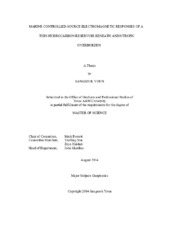| dc.description.abstract | In many cases of exploration geophysics, isotropic Earth forward models have been developed and measured data can be interpreted by inversion using this class of model. An isotropic model treats the Earth as a simple structure, in which the relevant physical properties do not vary with direction, and the interpretation of the measured responses requires relatively less effort compared to interpretations based on anisotropic models. However, the actual Earth has anisotropic physical properties. Thus, a better understanding of anisotropic Earth responses using the MCSEM method is the main objective of this thesis.
The controlled-source electromagnetic response in the frequency domain due to excitation by a horizontal electric dipole (HED) transmitter is herein evaluated over a layered seafloor consisting of a uniaxial anisotropic layer and an isotropic basement. Nominally, the upper uniaxial layer represents a thin-layered or interbedded earth formation caused by sedimentation over geologic time. Unlike an isotropic layer, a uniaxial layer is characterized by different values of electrical conductivity along two different directions.
To solve the MCSEM forward problem for a uniaxial model with vertical anisotropy, it is required to combine Faraday’s law and Ampere’s law without displacement current, thereby forming the governing pre-Maxwell’s equations. The resulting diffusion equation in the spatial (x, y) domain is converted to horizontal wavenumber (p, q) domain using a 2-D Fourier transform. The solution is analytic in the case of a uniaxial halfspace. The required source terms from an HED deployed in a conducting isotropic wholespace are derived from the Hertz vector potential and expressed, as usual in this type of problem, by Hankel transforms.
Numerical modeling is required to evaluate MCSEM responses of more complicated Earth models, whether isotropic or anisotropic. Herein, the response of a resistive disk located below a vertical anisotropic layer is considered. This serves to investigate the effect of the anisotropic overburden on resolving the underlying disk. The response of the resistive disk placed beneath the anisotropic layer is finally evaluated using a finite element method implemented in the code SEATEM, which was previously developed by Badea et al. (2001). | en |


